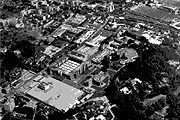IVREA is the manufacturing and residential area founded by the Olivetti company. It was built mainly between 1934 and 1985, and designed by a number of the best Italian architects of that period.
Ivrea, in Piedmont, is the home town of Olivetti. The growth of the Olivetti community spans over a century. The most intensive period extended from the 1930s to the 1960s and involved a large number of top architects, engineers, theoreticians and designers. The first factory was founded by Camillo Olivetti in 1895, and from 1908 onwards it began to produce typewriters. Adriano Olivetti, Camillo Olivetti's son, initiated the modernization of production and began to build the industrial landscape that is still visible today.
In the 1930s Ivrea was an original experiment of a corporative dream which linked the economy, territory and social programmes. Examples of this political and economic practice include the construction of workers' housing districts, several enlargements of the Olivetti offices and factories in Ivrea and the studies Olivetti promoted for the Aosta Valley plan (1934-1943).
After the Second World War, Adriano Olivetti became the head of a political party, called Movimento ComunitÓ, which proposed the reorganization of the territory into communities, where industry and social necessities were pacified: his book "L'Ordine Politico delle ComunitÓ" (1945) became a sort of agenda for the development of the city until his death in 1960.
The influence of Adriano Olivetti was not restricted to the construction of specific sites, but also had a profound impact on regional, urban and organisational thinking in the Canavese district, Italy and even abroad. The social and economic ideas of Olivetti were, in fact, based on original reflections about planning, which involved architects, planners and economists, and found a good field of experimentation in some very important Italian plans, such as the Martella village in Matera (1951-1954).
The economic crisis of the 1990s and subsequent evacuation of Olivetti from Ivrea have been met by a determined action to preserve the built heritage and the vitality of the town. The objective of the Officine Culturali ICO project has been to acquire economic funding and establish cultural and production-related initiatives in order to offer resources for the establishment of projects for the study, conservation and management of cultural assets in Ivrea and the Canavese area.
Most notable among these efforts is the MAAM (the Open Air Museum of Modern Architecture), which was launched in 1999. One of the actions of the Museum has been the cataloguing of local buildings. It led to the discovery of more than 200 buildings, directly or indirectly linked to the Olivetti Company, as well as the creation of restoration guidelines prepared and extensively tested in practice, and now consolidated in the new plan for the town (PRG Ivrea 2000). The original nature of the museum and its actions allowed the town to be nominated for the Melina Mercouri International Prize, awarded by UNESCO for the safe-guarding of cultural landscapes.
For Ivrea, the MOMONECO project is an opportunity to encourage deeper research of the architectural patrimony of the town and the preservation of its original cultural landscape, to encourage the city to re-think the destiny of the Museum as an opportunity for local development and, ultimately, to present Ivrea and the Museum as a landmark in the national and international debate on the transformation and development of the city.
Literature: Patrizia Bonifazio and Paulo Scrivano, Olivetti Builds. Modern Architecture in Ivrea, Skira, Milan, 2001
English language consultant: Gekko Design.
|

|

Aerial view of the Olivetti factory in Ivrea
|
